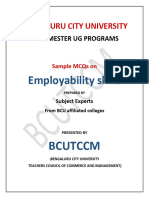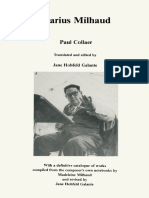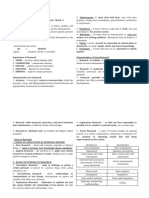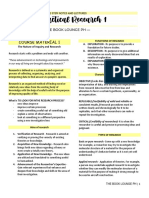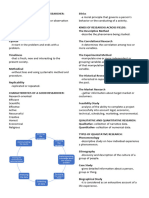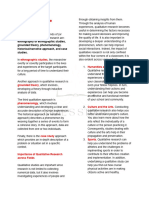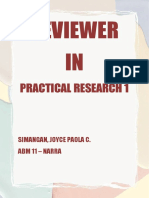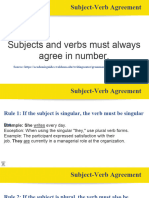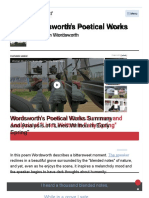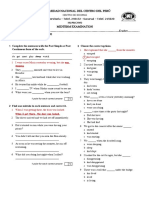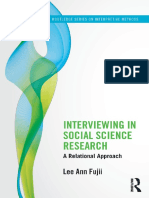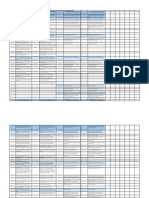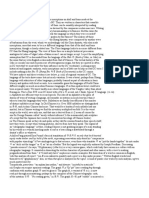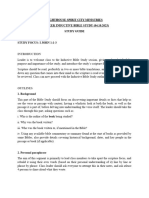0 ratings0% found this document useful (0 votes)
2 viewsResearch Reviewer 1
Research Reviewer 1
Uploaded by
joligo8143valCopyright:
© All Rights Reserved
Available Formats
Download as PDF, TXT or read online from Scribd
Research Reviewer 1
Research Reviewer 1
Uploaded by
joligo8143val0 ratings0% found this document useful (0 votes)
2 views6 pagesOriginal Title
RESEARCH-REVIEWER-1
Copyright
© © All Rights Reserved
Available Formats
PDF, TXT or read online from Scribd
Share this document
Did you find this document useful?
Is this content inappropriate?
Copyright:
© All Rights Reserved
Available Formats
Download as PDF, TXT or read online from Scribd
Download as pdf or txt
0 ratings0% found this document useful (0 votes)
2 views6 pagesResearch Reviewer 1
Research Reviewer 1
Uploaded by
joligo8143valCopyright:
© All Rights Reserved
Available Formats
Download as PDF, TXT or read online from Scribd
Download as pdf or txt
You are on page 1of 6
Lesson 1: Introduction to Research - designed to understand the variety of
behavior and perception of the audience
What is Research? - Results are descriptive rather than
- comes from the french word “cerchier” – to predictive
seek the prefix “re” means to repeat
- to repeat looking for something Most common designs:
- a systematic process 1. HISTORICAL RESEARCH
- deals in bringing in something new - systematic study of past events and
- root of human development– a human documents
product that is generating more new products 2. Ethnography / ETHNOGRAPHIC
and ideas RESEARCH
- focuses on indigenous or minority group
Why study RESEARCH? 2 PERSPECTIVES
- To become research literate - EMIC: insiders’ views
- To develop critical thinking - ETIC: outsider’s view
- To generate knowledge 3 ASPECTS OF INFORMATION IN ETHNO
- To come up with solutions to a certain problem CULTURAL BEHAVIOR
CULTURAL SPEECH
4 PHILOSOPHICAL VIEWS CULTURAL ARTIFACTS
1. POST POSITIVIST 3. PHENOMENOLOGICAL RESEARCH
- “We cannot be positive in our claims of - systematic study of the lived experiences of
knowledge when studying behavior and actions individuals
of humans.” - to understand life experiences and what makes
- subscribes to the idea that everything should it meaningful
be quantified to produce meaningful concrete - how people experience a phenomenon
results 4. CASE STUDY
2. CONSTRUCTIVIST - In-depth analysis of a single entity or a small
- “Individual develop subjective meaning of their group
experiences” - Used in discipline of sociology, nursing, and
- they believe that experience expressed psychology
through words can paint a better picture - seek to understand and answer the question
3. TRANSFORMATIVE why such situation occurred
- “research inquiry should be intertwined with 5. NARRATIVE ANALYSIS
politics and political change agenda” - Focuses on a specific story as the subject
- support that idea should be conducted to matter of inquiry
increase quality of life and produce better - The premises is on how individuals make
societies sense of their world by being able to
4. PRAGMATIC communicate
- “We need to look at many possibilities for 6. GROUNDED THEORY
collecting and analyzing data.” - systematic collection of data through
- promote the use of both qualitative and observation and interview to generate a
quantitative comprehensive explanation
- seek to understand the actions by discovering
Approaches in Research first main problem and then the person’s
• Qualitative Research behavior on resolving a problem
- an approach for exploring and understanding
the meaning individuals or groups ascribe to a • Quantitative Research
social or human problem. - an approach for testing objective theories by
- Collects and works with non-numerical data examining the relationship among variables.
- For exploring and understanding the meaning - for testing objective theories by examining the
of individuals or groups ascribe to a social and relationship among variables
human problem. - an objective, systematic empirical investigation
- Narrative, phenomenological, ethnography,
case study, grounded theory
- based on realities and different viewpoints of
individuals Kinds of Quantitative
1. DESCRIPTIVE RESEARCH 2. Explanatory sequential- first conducts
- concerned with describing the nature, quantitative and builds on the results to explain
characteristics, and components of the them in more detailed
population or a phenomenon 3. Exploratory sequential- begins with a
- no manipulation of variables qualitative and builds findings to develop a
2. CORRELATIONAL RESEARCH quantitative phase
- associations between and among variables
without investigation into casual reasons General Kinds of Research
underlying them Basic / Fundamental / Theoretical or Pure
3. EVALUATION RESEARCH Research
- aims to assess the effects, impacts, or - done for the purpose of knowing,
outcomes of practices, policies, or programs understanding or explaining natural and social
4. SURVEY RESEARCH phenomena;
- used to gather information from groups of - uncovers general principles and develop a
people by selecting and studying samples theory to explain such phenomena without direct
- cross-sectional- info is collected in just single or specific use at once;
point of time - most academic form of research.
- longitudinal- info is collected over a period of
time Forms of Basic/Theoretical Research
5. EXPERIMENTAL Discovery – where a totally new or novel idea
- utilizes scientific method to test or explanation emerges and may revolutionize
cause-and-effect relationship under conditions thinking.
controlled by the researcher Invention – where a new technique or method
6. CASUAL-COMPARATIVE RESEARCH is created.
- “ex post facto” (thafter the fact research) Reflection – where an existing theory, technique
- derives conclusion from the observations and or group of ideas is re-examined possibly in a
manifestations that already occurred in the past different organizational or social context.
MAJOR TYPES OF QUANTITATIVE Applied or Practical Research
RESEARCH - done for the purpose of testing or applying an
1. TRUE EXPERIMENTAL DESIGN existing principle or theory with the specific
- randomisation of participants purpose of improving the human condition.
- manipulation by having experimental groups
and control or comparison groups
- random assignment of treatment to groups 6 Forms of Applied Research
2. QUASI-EXPERIMENTAL DESIGN 1. Innovation- done in developing and coming
- randomisation of participants but restricted to up with a new, better or practical product,
pre-assigned groups process or technique out of the existing ones.
- manipulation with the presence of control Product development & packaging research are
groups part of this.
3. PRE-EXPERIMENTAL DESIGN 2. On-Farm or On-Field Level Research- done
- no randomisation of participants by testing the theories in the field or limited area
- presence of control group in some cases, but of application prior to implementation in
usually not large-scale.
- no random assignment of treatment to groups 3. Developmental Research- done by applying
the results of applied or practical research in a
• Mixed Approach wider scope of analysis and interpretation prior
– inquiry involving collecting both quantitative to mass implementation or production of outputs
and qualitative data, and integrating the two or results.
forms of data. 4. Evaluation or Assessment Research-
pursues to find out the worth, merit or quality of
Different types of Mixed Approach a certain object, program or project.
1. Convergent parallel- merges quantitative 5. Orientational Research
and qualitative data, - done for the purpose of advancing an
ideological position.
- more focus on inequality, discrimination, - In qualitative studied primarily focuses on
empowering and emancipation of the life-related concepts that are commonly
marginalized groups or ideas to eliminate non-measurable. often entails narration of past
alienation and domination. experiences
6. Action Research Intellectualized topic - specificity of study,
- based on the concept that ‘action is both an distinctiveness of your research
outcome and a part of research’.
- focuses on solving local problems or SOURCES OF RESEARCH TOPIC
immediate problematic situations for the - own experience and interest
practical concerns of the involved people. - own professional practice
- colleagues
THE RESEARCH PROCESS (5) - critical friends (experts in the field)
1. CONCEPTUALIZATION PHASE - Related literature
- topic is identified
- studies are recommended to focus on a Lesson 2: Chapter 1: Introduction (The
not-too-broad but not-too-specific concept Problem and its Background)
- Literature reviews may be present and are - This chapter provides an overview of study and
required for quantitative studies but optional in its background
quali inquiries - Comprises the reasons why the particular
- Topic selection is followed by objective framing problem is being presented, the previous
or identifying the “central questions” researches about similar topics, the importance
2. DESIGN PHASE of the study, as well as the operational terms
- Known as planning phase used throughout the research
- decide on the detailed procedures in gathering
and analyzing data Include the following:
- how, where, and when will the study be - Introduction
conducted and analyzed is addressed - Background of the study
3. EMPIRICAL PHASE - Objective of the study
- Actual data gathering and collection - Statement of the problem
- researchers are equipped with the necessary - Hypothesis
attitude, behavior, and tools in gathering data - Scopes and delimitation
- Respondents are known as key informants or - Significance of the study
co-researchers - Definition of terms
4. ANALYTICAL PHASE
- most challenging phase of the research Introduction
- Preparation and assessment of data through Discusses 4 relevant ideas:
the use of different tools and the researchers - Topic or subject matter
own understanding - Importance of the topic
- analysis of data - Reason for choosing the topic
5. DISSEMINATION PHASE - Purpose of the study
- Most valuable but often neglected by the
researchers Background of the study
- research results in the form of a well-written full - Consists of statements and/or factors that led
research manuscript the investigator to launch the study
- A brief rationale to justify the problem
RESEARCH TOPIC - A present state of knowledge regarding the
- an intellectual stimulus calling for an answer in problem
the form of scientific inquiry - The researchers can state the antecedents of
3T’s the study, the reasons why it is relative to
- timely previous studies.
- trending
- trailblazing
- area of the study, common ground
Objective of the study Lesson 3: Chapter 2: Review of Related
- Statement of a long-term objective expected to Literature
be achieved by the study. - This chapter reviews several studies and
- It is usually prefixed by this introductory literature which were written by local and foreign
phrase: “The main objective of this study is to…” authors containing valuable information the
researchers need as they undertake the study.
Statement of the problem This chapter also provides the rational
- Specific questions which are to be answered in explanation in conducting the study.
the study.
- It can be a general statement of the whole Include the following:
problem followed by specific questions or - Review of foreign literature
sub-problems into which the general problem is - Review of local literature
broken up. - Theoretical framework
- Conceptual framework
Hypothesis - Research paradigm
- A tentative answer to a research problem
- NULL Hypothesis is the one that states NO Purposes/functions of RRL
relationship between variables. Its function is to - To provide justification of the study
let the research test the hypothesis statistically; - To identify gaps, problems, and needs of
denoted by Ho related studies
- ALTERNATIVE Hypothesis is usually taken to - To provide rationale of the study as well as the
show that the observations are the result of a reasons of conducting the study
real effect; denoted by Ha - To have basis that will be used to support
findings of the study
Scope and delimitation
- The SCOPE describes the coverage of the 3 Kinds of Literature Review
study; specifies what is covered in terms of 1. CONCEPTUAL LITERATURE- it contains
concept, number of subjects, and timeline when foreign and/or local literature coming from
the study was conducted. books, journalism, and other forms of material,
- DELIMITATION refers to factors or variables concerning or relevant to the study, but are
that are not included in the study and the data-free or non-empirical material.
boundary in terms of time frame, number of 2. RESEARCH LITERATURE- these are
subjects who are excluded; empirically-based, like scientific paper, theses,
Specify those that you will not deal with the and dissertations, both published and
study. unpublished, coming from local and foreign
sources.
Significance of the study 3. GRAY LITERATURE- from other sources
- In this part, the researchers define who will such as magazines, newspapers, flyers and
benefit out of the findings of the study and how other forms of material.
they will benefit from it.
6 Types of Literature Review
Definition of terms 1. ARGUMENTATIVE REVIEW- examines
- Only terms, words, or phrases which have literature selectively in order to support or refute
special or unique meanings or roles in the study an argument, deeply embedded assumption, or
are defined. philosophical problem already established in the
- Terms should be arranged alphabetically. literature; the purpose is to develop a body of
- Terms should be defined operationally and literature that establishes opposite perspective.
conceptually. 2. INTEGRATIVE REVIEW- most common form
2 kinds of definition: of review; it reviews, critiques, and synthesizes
Conceptual definition – describes what a representative literature on a topic in an
construct or word actually means; dictionary integrated way such that new frameworks and
meaning perspectives on the topic are generated.
Operational definition – describes how the
particular construct or word was used in the
study.
3. HISTORICAL REVIEW- a flowing, dynamic DIRECT QUOTATION- use quotation, includes
account of past events which involves an page number
interpretation of these events in attempt to INDIRECT- no quotation marks
recapture the nuances, personalities, and ideas CITATIONS FROM A SECONDARY SOURCE
that influenced these events.
4. METHODOLOGICAL REVIEW- focuses on Theoretical Framework
HOW authors/researchers came about their - Foundation of the research study; highly
study; it reviews methods conducted in the study related theories and principles that were
which may include research approaches, data established and proven by experts/authorities.
collection, and analysis techniques.; this kind of - Refers to set of interrelated construct,
review helps highlight ethical issues that one definitions, and prepositions that presents a
should be aware of and consider. systematic view of phenomena.
5. SYSTEMATIC REVIEW- the purpose of this
form is to attain conclusion regarding the chosen Conceptual Framework
topic; it consists of an overview of existing - A tentative explanation of the phenomenon or
evidence pertinent to a clearly formulated problem and serves as the basis for the
research question. formulation research hypotheses.
6. THEORETICAL REVIEW- examines the body
of theory that has accumulated in regard to an Research Paradigm
issue, concept, or phenomena; helps establish - A diagrammatic representation of a conceptual
what theories already exist, the relationship framework.
between them, to what degree the existing - It shows the flow of the research and how the
theories have been investigated, and to develop study will be conducted.
new hypotheses to be tested. - It should follow the IPO Model
(INPUT-PROCESS-OUTPUT)
CITATION STYLE: INPUT: Who are your respondents?
- predefined styles stating how to properly cite PROCESS: How will the study be conducted?
and give credit to the sources of your literature OUTPUT: What are the expected results of the
IMPLICIT- statement_(Authors, year) study? (main objective)
EXPLICIT- author_(year) verb statement
INTRODUCTORY- 3.0 RESEARCH METHODOLOGY
verb_author_(year)_statement - the researchers writes each subsection
concisely yet completely to provide enough
CITATIONS GUIDELINES: detail
1. If the citation is not at the end of the text, - ensures that the study has undergone scientific
include the surname of the author and the process and that the tools utilized in the study
year—--- According to Flippo (1984),... are valid and reliable
2. if the citation is at the end of the text, include
the author’s name and the year in one 3.1 RESEARCH DESIGN
parenthesis—------ (FLIPPO, 1984) - discusses the approach (quali or quanti) and
- WORKS BY MULTIPLE AUTHORs design (pheno, experimental, descriptive)
3. (has two authors) always cite both names - the reason (s) why the design was chosen
everytime the reference occurs must be justified here
- in narrative text, ipagjoin ang
two names using “and” 3.2 RESEARCH LOCALE
- in parenthetical material, using - geographical characteristics of the place of
ampersand (&) study
4. (more than two) cite all the authors the first - setting
time the reference occurs - anonymity must always be observed
5. kapag second or third time nang
mababanggit, gamitin na lang yung first author 3.3 POPULATION AND SAMPLING/ KEY
followed by “et.al” INFORMANT SELECTION
- demographic characteristics of the participants
IN-TEXT CITATION- used when directly quoting - number and profile of respondents, sampling
or paraphrasing a source technique used
SAMPLING- process of selecting the sample THREE FREQUENTLY USED METHOD
POPULATION- consists of all the members of 1. COLAIZZI'S METHOD- one that calls
the group for returning back to study participants
SAMPLE- a portion or part of the population, 2. GIORGI’S METHOD- …relies solely on
subset of the population elements researchers
- REPRESENTATIVE SAMPLE- one 3. VAN KAAM’S METHOD- requires that
whose characteristics closely intersubjective agreement be reached
approximate those of the population with other expert judges
- COOL AND WARM ANALYSIS
TYPES OF NON- PROBABILITY SAMPLING Cool analysis– extracting significant
CONVENIENCE SAMPLING- selection of the statements
samples based on the convenience of the Warm analysis– grouping, sorting and
researcher/s —-- accidental sampling assigning themes
PURPOSIVE SAMPLING- based on the STEPS IN ANALYZING QUALITATIVE DATA
selective judgment of the researchers — 1. DATA COLLECTION
judgmental sampling, there is a criteria set by 2. TRANSCRIPT (FIELD TEXT) -
the researchers translation between forms of data,
convert audio recordings to text
QUOTA SAMPLING- the researchers identify VERBATIM TRANSCRIPTION- art of converting
population sections or strata and decide how spoken word into text such that a message is
many participants are required from each captured exactly the way it has been spoken.
section, stratification is based on variables, includes pauses and non-verbal utterances or
allows better representation of the population fillers such as “umm,” clearing throat clearing,
laughter, silence, facial expressions and
SNOWBALL SAMPLING- “refer” —------ based gestures
on the assumption that people who share the NON-VERBATIM TRANSCRIPTION- includes
same traits know each other, useful for subjects all the fundamental meaning behind the spoken
who are hard to find statements are captured and other factors are
eliminated. does not include filler words or
TYPES OF PROBABILITY SAMPLING sounds
SIMPLE RANDOM SAMPLING - “most basic” 3. CODING
- based on chance and each member has equal Requires the researchers to assign a
chance of being selected as a sample code to extracted significant statements from the
Example: FISHBOWL TECHNIQUE field text
SYSTEMATIC SAMPLING- a process of
selecting the “kth” element —-------- (P1 OR R1: 7) —- (before the colon)
n= sample size pertains to kung pang-ilan yung participant
N= size of the population or respondent —------- (after the colon) refers
—------------------------ through dividing these two to significant statement/ sop number___
(N/n=k), sampling interval width (k) is 4. CLUSTERING/ CATEGORIZING
determined Extracted data is converted to
SAMPLING INTERVAL: standard distance manageable units. Extracted significant
between element chosen for the sample statements which are similar are put together
STRATIFIED SAMPLING- the population is 5. FORMATION OF THEMES
divided into subgroups or strata. After the THEME: an abstract entity that brings
stratification, an appropriate no. of elements are meaning and identity to a recurrent
selected from each stratum randomly. experience. it captures and unifies the
CLUSTER SAMPLING- a method of selecting nature or basis of the experiences
cluster from a population that is large 5.0 DISCUSSION
Also known as multi-stage sampling CONCLUSIONS - focuses on the summary of
findings, includes the conclusion of the array of
4.0 RESULTS concepts formed. it answers the res questions
- this is how the researchers make sense of
massive amounts of data… RECOMMENDATIONS- corresponding
suggestions based on the results
You might also like
- Bare BonesDocument48 pagesBare Bonesmgharba123No ratings yet
- Sample MCQs On Employability Skills 2Document20 pagesSample MCQs On Employability Skills 2rohitkrajbhar9281100% (1)
- Darius Milhaud by Paul Collaer (Auth.), Jane Hohfeld Galante (Eds.)Document422 pagesDarius Milhaud by Paul Collaer (Auth.), Jane Hohfeld Galante (Eds.)mmarriuss7No ratings yet
- Practical Research 1 OutlineDocument5 pagesPractical Research 1 OutlineCharlesVincentGalvadoresCarbonell100% (7)
- Cerhier Which Means "Seek" and The: Practical Research 1: ReviewerDocument3 pagesCerhier Which Means "Seek" and The: Practical Research 1: ReviewerPia CelesteNo ratings yet
- Research ReviewerDocument8 pagesResearch ReviewerZelian ShcwienNo ratings yet
- PR ReviewerDocument4 pagesPR ReviewerShane CanoNo ratings yet
- Research NotesDocument17 pagesResearch NotesUpsurge GAMERNo ratings yet
- PR ReviewerDocument4 pagesPR Reviewerjugadovince11No ratings yet
- Reviewer D2Document13 pagesReviewer D2Nate Dela VegaNo ratings yet
- Nature of Inquiry and ResearchDocument19 pagesNature of Inquiry and Researchbiker guyNo ratings yet
- Day 1 Reviewer 3Document13 pagesDay 1 Reviewer 3Catherine De QuintosNo ratings yet
- Eapp ReviewerDocument3 pagesEapp Reviewerchaybautista698No ratings yet
- RDLDocument6 pagesRDLEKIMISS PHNo ratings yet
- PsycRes RevDocument4 pagesPsycRes RevNicole EusebioNo ratings yet
- 2ND Term - Practical Research 1Document10 pages2ND Term - Practical Research 1Mark Anthony100% (1)
- Practical Research 1 HandoutsDocument3 pagesPractical Research 1 HandoutsSophia AngelaNo ratings yet
- PR PDFDocument2 pagesPR PDFJosh EspirituNo ratings yet
- Reviewer in PR1 - QTR3Document2 pagesReviewer in PR1 - QTR3John Gil GomezNo ratings yet
- Pr1 Reviewer q1 Practical Research 1Document4 pagesPr1 Reviewer q1 Practical Research 1Jerelyn MalacasteNo ratings yet
- PR2 HeDocument12 pagesPR2 HeJay-r MatibagNo ratings yet
- MT ReviewerDocument13 pagesMT ReviewerZari RiegoNo ratings yet
- RM AssignmentDocument3 pagesRM Assignmentmanpreet kaurNo ratings yet
- CRIMINOLOGY 7 Criminological Research 1Document8 pagesCRIMINOLOGY 7 Criminological Research 1euniceNo ratings yet
- 2nd-Semester-Midterm-Reviewer 3Document48 pages2nd-Semester-Midterm-Reviewer 3Justin BorjaNo ratings yet
- Approaches To Enquiry:: The Quantitative ApproachDocument3 pagesApproaches To Enquiry:: The Quantitative Approachmanpreet kaurNo ratings yet
- Reviewer in Pr1 Qtr3Document2 pagesReviewer in Pr1 Qtr3Jovelle DiazNo ratings yet
- Research Reviewer Good LuckDocument6 pagesResearch Reviewer Good LuckCheane GaniaNo ratings yet
- Business Research Reviewer 1.1Document4 pagesBusiness Research Reviewer 1.1clytesandejasNo ratings yet
- Ridl ReviewerDocument7 pagesRidl ReviewernalaunankaiNo ratings yet
- Pras01a Quiz PDFDocument4 pagesPras01a Quiz PDFJan-Rhada AmarilaNo ratings yet
- Data CollectionDocument17 pagesData CollectionMeimeiNo ratings yet
- Quantitative QualitativeDocument3 pagesQuantitative QualitativemariaNo ratings yet
- Research II Quarter 1 LR 1Document25 pagesResearch II Quarter 1 LR 1Almalyn Alimin MohammadNo ratings yet
- Mia g10 q1 All Sub ReviewerDocument3 pagesMia g10 q1 All Sub ReviewerAblen Sibling'sNo ratings yet
- Chapter 1Document33 pagesChapter 1Eid MohamedNo ratings yet
- Importance of ResearchDocument11 pagesImportance of Researchmaxiie mirandaNo ratings yet
- PR1 Quarter 3 Topics - 111601Document8 pagesPR1 Quarter 3 Topics - 111601janela1230No ratings yet
- Practical Research 1Document3 pagesPractical Research 1razshellareignNo ratings yet
- Practical ResearchDocument8 pagesPractical ResearchanggelungubNo ratings yet
- Methods Exam CoverageDocument9 pagesMethods Exam CoverageMartin Laurence Garcia PlasabasNo ratings yet
- Qualitative ResearchDocument2 pagesQualitative ResearchLucy TagalaNo ratings yet
- Notes On NRES Review 1Document7 pagesNotes On NRES Review 1May Justine RicardoNo ratings yet
- Practical Research: Module 2: Identifying The Inquiry and Stating The ProblemDocument9 pagesPractical Research: Module 2: Identifying The Inquiry and Stating The ProblemTricia VelascoNo ratings yet
- PR 1 Reviewer Periodicals Q3Document11 pagesPR 1 Reviewer Periodicals Q3Irishh TrinidadNo ratings yet
- Lesson 1: Nature of Inquiry and ResearchDocument18 pagesLesson 1: Nature of Inquiry and ResearchKevin ZhaskerNo ratings yet
- pr1 ReviewerDocument3 pagespr1 ReviewerSheena DumayNo ratings yet
- Practical Research 1 NotesDocument17 pagesPractical Research 1 NotesteiNo ratings yet
- Hand Out 1isshsjshsjsshsjDocument4 pagesHand Out 1isshsjshsjsshsjkuroko100907No ratings yet
- Reviewer IN: Practical Research 1Document19 pagesReviewer IN: Practical Research 1Joyce Paola Calingasan Simangan100% (1)
- Research Skills CompleteDocument15 pagesResearch Skills Completekibet kennedyNo ratings yet
- InquiryDocument16 pagesInquiryArnel MoradoNo ratings yet
- Para Makagraduate Ft. ResearchDocument12 pagesPara Makagraduate Ft. ResearchsheriNo ratings yet
- PR NotesDocument13 pagesPR NotesalliyahmuanaNo ratings yet
- Compilation of All ReportsDocument56 pagesCompilation of All ReportsJoseph Vincent A SalvadorNo ratings yet
- Reviewer in Practical Research 1Document5 pagesReviewer in Practical Research 1rci.marizdimaapiNo ratings yet
- Lesson 1: Content 2: Qualitative Research - Is A Scientific Method of Observation To Gather Non-Numerical DataDocument2 pagesLesson 1: Content 2: Qualitative Research - Is A Scientific Method of Observation To Gather Non-Numerical DataMelody ArandelaNo ratings yet
- Unit 2, Lesson 3: Qualitative ResearchDocument6 pagesUnit 2, Lesson 3: Qualitative ResearchJessy RoseNo ratings yet
- Ic Res PrelimDocument8 pagesIc Res PrelimaceNo ratings yet
- Day 1 Reviewer in ResearchDocument3 pagesDay 1 Reviewer in ResearchJehance TulioNo ratings yet
- Research Methods - NOTESDocument6 pagesResearch Methods - NOTESAsheika Charles100% (1)
- PR1 - Unit 1 NotesDocument7 pagesPR1 - Unit 1 NotesBluvrNo ratings yet
- Subject Verb AgreementDocument35 pagesSubject Verb AgreementAdielNo ratings yet
- WWW Gradesaver Com Wordsworths Poetical Works Study Guide Summary Lines Written in Early SpringDocument11 pagesWWW Gradesaver Com Wordsworths Poetical Works Study Guide Summary Lines Written in Early SpringTESL30621 Tharsinii Ap R JayasilanNo ratings yet
- Básico 11-MIDTERM EXAMDocument5 pagesBásico 11-MIDTERM EXAMAngel JavierNo ratings yet
- The Writer - May 2023Document52 pagesThe Writer - May 2023JulioNo ratings yet
- Download The New Cambridge Companion to Herman Melville 2nd Edition Robert S. Levine ebook All Chapters PDFDocument81 pagesDownload The New Cambridge Companion to Herman Melville 2nd Edition Robert S. Levine ebook All Chapters PDFromicsleath100% (3)
- A Short Story: The Golden EggDocument2 pagesA Short Story: The Golden EggParvinaNo ratings yet
- Unit 5 NotesDocument13 pagesUnit 5 Notesshashank reddyNo ratings yet
- Postcolonial Perspectives in The Booker Winning Indian NovelsDocument7 pagesPostcolonial Perspectives in The Booker Winning Indian NovelsEditor IJTSRDNo ratings yet
- X-mas 2024 - New Year 2025Document11 pagesX-mas 2024 - New Year 2025Karin RichterNo ratings yet
- The Conjurer's Revenge by Stephen LeacockDocument3 pagesThe Conjurer's Revenge by Stephen LeacockShajini SNo ratings yet
- (Routledge Series On Interpretive Methods) Lee Ann Fujii - Interviewing in Social Science Research - A Relational Approach-Routledge (2018)Document135 pages(Routledge Series On Interpretive Methods) Lee Ann Fujii - Interviewing in Social Science Research - A Relational Approach-Routledge (2018)stefan morarNo ratings yet
- Feminist LPDocument3 pagesFeminist LPJovilyn DegenionNo ratings yet
- The Sanatan Dharma 2Document60 pagesThe Sanatan Dharma 2Sarthak Meena100% (1)
- Book Review Humss 11 BDocument14 pagesBook Review Humss 11 BHungryNo ratings yet
- Group 4Document29 pagesGroup 4Hazel NatividadNo ratings yet
- Maggie Clinton - Revolutionary Nativism - Fascism and Culture in China, 1925-1937-Duke University Press Books (2017)Document281 pagesMaggie Clinton - Revolutionary Nativism - Fascism and Culture in China, 1925-1937-Duke University Press Books (2017)Rejane Carolina HoevelerNo ratings yet
- FINAL 2022-2023 TDS G9-12 Competencies Adventure Humanities Focal Points, Power Standards, and Learning OutcomesDocument35 pagesFINAL 2022-2023 TDS G9-12 Competencies Adventure Humanities Focal Points, Power Standards, and Learning OutcomesTuân NguyễnNo ratings yet
- The Feather PillowDocument8 pagesThe Feather PillowScribdTranslationsNo ratings yet
- G11 WHLP 21ST Century Literature From The PhilippinesDocument8 pagesG11 WHLP 21ST Century Literature From The PhilippinesasdfghdnyNo ratings yet
- The Gift of The Magi AnalysisDocument16 pagesThe Gift of The Magi AnalysisCatur NurNo ratings yet
- Relative Pronouns 2Document1 pageRelative Pronouns 21°B -Sophia Valentina CALDERON ABANTONo ratings yet
- Odes Is A Murky One and Its Poems Are of Heterogeneous Origin, But They Are Quoted So OftenDocument9 pagesOdes Is A Murky One and Its Poems Are of Heterogeneous Origin, But They Are Quoted So OftenDavid MccrawNo ratings yet
- PeaceDocument1 pagePeaceAl-Haqq Foundation AcademyNo ratings yet
- Inductive Bible Study Guide 2Document3 pagesInductive Bible Study Guide 2Chisom ChibuezeNo ratings yet
- Foreign Accounts: Greek, Chinese and Arab Writers: Part I - Self Study HistoryDocument3 pagesForeign Accounts: Greek, Chinese and Arab Writers: Part I - Self Study Historykanak singhNo ratings yet
- The Last Rose of Summer: (Martha)Document2 pagesThe Last Rose of Summer: (Martha)Avelyn ChuaNo ratings yet
- Insulin As A Substance of MisuseDocument5 pagesInsulin As A Substance of MisuseStephany Mae ChiNo ratings yet

